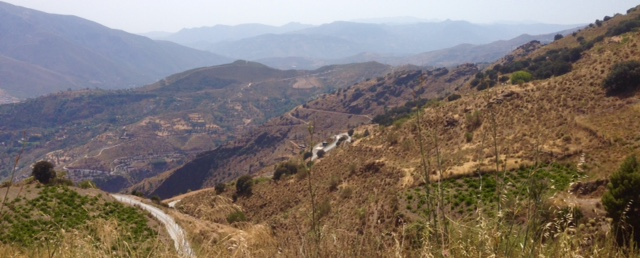After Mojacar (see the posts pre-Barcelona) we drove from east to west throughout this region. We covered more places here than I will post on, and one could spend days travelling from one place to another where there were atrocities – and atrocities on both sides. Take, for example, Cádiar where in 1568 Christian soldiers billeted there were killed while sleeping; or Laujar de Andarax where 3000 Muslims were killed, including 200 (some reports say 600) women and children who were blown up inside the Mosque.
There were a series of ‘rebellions’ in the decades that followed the surrender of Granada (1492). This was mainly throughout the mountainous regions south and east of Granada, and was provoked by the very harsh anti-Muslim policies of Francisco Jiménez de Cisneros, who with the royal court moved to Granada in 1499. He ordered the burning of Arabic books and advocated a very hostile policy of forced conversions. His actions were in violation of the agreement that had been reached on the surrender of Granada.
We are noting a repeating pattern: take what is not yours, opens a door to betrayal, that then releases a spirit of destruction and murder.
Again in the midst of the overarching story there is a story of mercy. Cisneros became very ill and there were real concerns whether he would survive the illness. Finally a Muslim woman skilled in natural medicine treated him and he recovered. Sadly rather than this soften him it seems he was more resolved to counter the Muslim threat and was later able to apply the same policies beyond the borders of Spain. At the end of the rebellions the population of the kingdom of Granada had dropped from 150,000 to around half that figure. They were expelled from their land, again it is only appropriate to also give this the label of ‘civil’ war alongside any other labels attributed to those years of brutality.

History is normally written by the victors and it was interesting to read in Órgiva town square about the rightful heirs being given the city. The rightful heirs were from Córdoba – some 3 hours drive away to the north. Apparently the rightful heirs were not those of the land.
There were so many places that we drove through and a number we stopped off at, either on the main road or small villages normally higher up the mountains. One place I will mention: Pitres. Driving there we came across two blights on the land. A well-established Buddhist retreat centre and all-but next door a town (Soportújar) with a public sign describing it as a ‘village of witchcraft’. Both we are sure sitting on the huge bloodshed across the valley. The valley is called the barranco de sangre (ravine of blood). Legend has it that it so flowed with blood that it never flowed with water again after that time. Blood on the land, particularly where it is tied to betrayal makes space for the demonic to sit there. All kinds of spirituality flourish in the Alpujarra(s).

The satellite map above will give some idea of the terrain. We came in from the East through Alhama de Almeria and out through Lanjaron – then up to Granada the following day.
It was a long day through the mountains, but it was also a long day spiritually. It is easy to be overcome by the immensity of what one encounters and we certainly do not have a perspective that somehow we have ‘done’ it. We though have, hopefully, made a contribution, and being convinced that God is not looking for the next ‘big thing’ but to presence himself in the midst of the multiplicity of small things we are content.
We are getting ready now for our next trip (which will take us into Portugal) and will begin by returning to the Alpujarras on Sunday, spending the Monday in there with a Spanish couple that we have yet to meet but are of the land. If we can strengthen them we will be content, helping those who love the land (rightful heirs) to create space for the Spirit of God.
